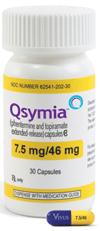 Optometrists know the ocular side effects of Topamax (topiramate, Janssen), which is used to prevent epileptic seizures and migraine headaches. Interestingly, when researchers analyzed patients who used this drug, they found that subjects also lost weight.
Optometrists know the ocular side effects of Topamax (topiramate, Janssen), which is used to prevent epileptic seizures and migraine headaches. Interestingly, when researchers analyzed patients who used this drug, they found that subjects also lost weight.
In mid-July, the FDA approved Qsymia (phentermine/topiramate extended-release, Vivus) to control weight in adults with a body mass index (BMI) of 30 or greater (obese) or adults with a BMI of 27 or greater (overweight) who have at least one weight-related condition, such as hypertension, type 2 diabetes or high cholesterol.
Approximately one-third (35%) of American adults (more than 78 million people) and nearly 17% of teenagers and children (about 12.5 million) are obese, according to the Centers for Disease Control and Prevention.
“We see a fair number of patients with seizure disorder who are on Topamax,” says Jimmy D. Bartlett, O.D., chairman and CEO of Pharmakon Consulting Group. “But considering the number of people who are overweight and obese in the United States, the sheer number of potential patients who could be on Qsymia will increase the risk for optometrists to see adverse ocular effects in the office.”
Induced myopia and angle-closure glaucoma are the two main adverse ophthalmic effects of topiramate, Dr. Bartlett says.
If your patient is on Qsymia, keep an eye on the patient’s refractive error and watch for any indication of increasing myopia, he says. Consider gonioscopy to inspect the anterior chamber angle for evidence of angle closure.
If a patient comes in with acute symptoms of blurred distance vision or pain along with increased intraocular pressure, it could indeed be secondary angle-closure glaucoma, Dr. Bartlett says.
This is different from primary angle-closure caused by pupillary block. So, “absolutely avoid pilocarpine,” he says. Instead, “utilize a cycloplegic, like cyclopentolate or homatropine, to relieve the secondary angle closure, followed by the normal methods for reducing acutely elevated intraocular pressure, such as beta-blockers, carbonic anhydrase inhibitors or alpha-2 agonists.”
See also Glaucoma Grand Rounds, “New Diet Drug Also ‘Slims’ Eyes."

